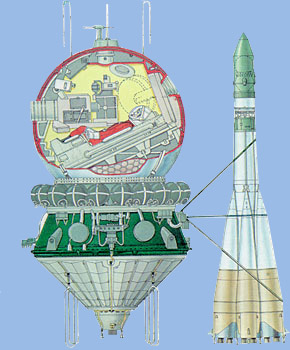
Space program «Vostok»
Manned space programs
Space program Vostok (Russian for “East”) was Soviet human spaceflight project that succeeded in putting a person into Earth's orbit for the first time.
Vostok – is the name of a series of the Soviet spacecraft. Vostok spacecraft was the first manned spacecraft in the world. It was developed in 1958, by Special Design Bureau OKB-1 under the leadership of Chief designer Korolev S.P. The unmanned spacecraft - 1K (Vostok-1) was created in order to test major systems of the Vostok spacecraft in test flights. The manned spacecraft was designated as 3KA (Vostok-3A). Vostok spacecraft was to put only one cosmonaut into Earth's orbit. Maximum estimated flight duration - 10 days. Mass of the spacecraft - more than 4,700 kg, length - 4.3 meters, maximum diameter - 2.5 meters. Vostok consisted of two modules: the descent module and instrument compartment with TDU-1 retropropulsion system. During the whole flight the cosmonaut was suited in SK–1 spacesuit connected to the onboard life support system. Cosmonaut Valentina Tereshkova performed the flight onboard Vostok-6 suited in SK-2 spacesuit. On reentry, the cosmonaut would eject from the craft at about 7,000 m (23,000 ft) and descend via parachute, while the capsule would land separately. The Vostok spacecraft was launched using Vostok launch vehicle, meanwhile the spacecraft was put under the shroud which was 6.63 meters long with maximum diameter of 2.58 meters. There was a hatch in the shroud for emergency ejection of a cosmonaut. In the emergency event of the launch vehicle on the launch pad or during the initial ascent, a cosmonaut would be ejected from the capsule.
In order to make the human space program possible Cosmonaut Training Center was built and cosmonauts selected. The first cosmonaut corps consisted of qualified Air Force pilots who took part in the special selection. The first manned Vostok, launched April 12, 1961, became the first spacecraft succeeded in putting a person into Earth's orbit for the first time.
The main results achieved by this program: first of all political (the first man in space, the first woman in space, the first group flight of two spacecrafts, a record flight duration for those years), scientific (a person can live and work in space, the research of the problems related to exposure to weightlessness on humans began immediately). Vostok preceded the Voskhod program.
Provided that the first Vostok, piloted by Yuri Alekseyevich Gagarin, made only one complete revolution around the Earth, lasted 108 minutes, Vostok-5 spacecraft with cosmonaut Valery Fedorovich Bykovsky onboard performed flight lasted about 5 days. This time was enough for the spacecraft and the cosmonaut to make 81 revolutions round the Earth.
There were 13 spaceflights in the Vostok program: 6 manned (3KA) and 7 unmanned spaceflights (5 1K spacecrafts and 2 3KA spacecrafts).